27desert garden is your go-to spot for transforming arid spaces into vibrant oases. Here, you’ll find a delightful mix of low-maintenance plants, practical gardening tips, and creative design ideas, all geared towards making the most of your desert landscape. Dive in and discover how to cultivate beauty in the sunniest of settings!
Designing Pathways with Natural Materials

Creating pathways in a desert garden is all about blending style with nature. The image shows a beautiful path made from natural stones. These stones are arranged thoughtfully, guiding you through the lush greenery of the garden.
The pathway’s design complements the surrounding landscape. The combination of gravel and flat stones enhances the natural look, making it a welcoming route for visitors. This design not only provides a practical way to navigate the garden but also adds an artistic touch.
When choosing materials, consider what fits best with your garden theme. Natural stone is a fantastic choice due to its durability and organic appeal. You can even mix in some gravel for extra texture and a more rustic feel. This creates a casual atmosphere, inviting people to explore.
Don’t forget about maintenance. A well-maintained pathway ensures that your garden remains inviting. Regularly check for any displacement of stones and replenish gravel as needed. This keeps your pathway safe and looking fresh.
Incorporating Native Desert Flora

Creating a desert garden is all about embracing the beauty of native plants. In the image, vibrant yellow and pink blooms stand out against a backdrop of arid earth. These colorful flowers aren’t just pretty; they’re well-suited to thrive in the harsh desert climate.
Using native flora is a smart choice for low-maintenance gardening. These plants have adapted to local conditions, requiring less water and care. The bright yellow flowers in the image, for instance, add cheer to the landscape and attract local pollinators like bees and butterflies.
Additionally, adding succulents and cacti offers depth and texture. The tall, spiky plant in the background adds an interesting vertical element. Together, these plants create a balanced look that captures the essence of the desert.
Consider grouping plants with similar watering needs. This helps maintain a sustainable garden without excessive overlap. By doing this, you not only conserve water but also promote a healthy ecosystem right in your backyard.
Maximizing Sunlight Exposure

In a desert garden, sunlight is key to thriving plants. This image shows a variety of cacti and succulents, each designed to soak up as much sun as possible. The tall, slender cactus captures sunlight from different angles, while the round, compact plants are perfectly adapted to store water.
Arranging plants based on their sunlight needs can make a big difference. For instance, taller cacti can provide some shade for smaller plants during the hottest parts of the day. This strategic placement helps maximize sunlight exposure while protecting more delicate varieties.
It’s also essential to consider the time of day. Morning light is usually softer, making it a gentle start for all plants. In contrast, the afternoon sun can be harsh, so knowing when to position your plants can keep them healthy.
Using light-colored gravel or sand, as seen in the image, can help reflect sunlight, giving the plants an extra boost. Plus, it creates a beautiful contrast with the green and brown tones of the garden.
Understanding Soil Composition in Arid Regions

The desert landscape in the image illustrates the unique environment of arid regions. In the foreground, a variety of cacti and desert plants thrive, showing how life adapts to these tough conditions. The layered soil beneath the surface is just as vital as the visible plants above.
In arid areas, soil composition is critical for supporting plant life. The different layers depicted highlight how materials like sand, clay, and organic matter come together. Each layer has its own characteristics that influence water retention and nutrient availability.
Take a closer look at the labels of the soil layers. They suggest a scientific approach to understanding the types of soil found in this desert setting. For instance, sandy soils drain quickly but may not hold nutrients well. In contrast, clay-rich layers can trap moisture, yet they often become compacted.
Understanding these soil layers helps us appreciate how plants like cacti survive. They have adapted over time to store water and thrive even in harsh conditions. Knowledge of soil composition is essential for anyone looking to cultivate a garden in similar environments.
Utilizing Mulch for Moisture Retention

In the desert garden setting, using mulch is a fantastic way to keep your plants healthy. The image showcases a well-mulched area, where bits of wood and organic material are scattered across the ground.
Mulch acts like a blanket for the soil, trapping moisture and preventing evaporation. This is especially important in hot, dry environments where water is scarce. By covering the soil, mulch helps maintain a cooler temperature and creates a better environment for plant roots to thrive.
Different types of mulch can be used, from wood chips to straw. In this image, you can see a mixture that not only helps retain moisture but also adds a natural look to your garden. As it breaks down, organic mulch improves soil quality, which is an added bonus!
Incorporating mulch into your desert garden is a simple step that pays off in healthier plants and less watering. Whether you’re aiming for a lush landscape or just trying to keep things blooming, mulch is definitely a helpful tool.
Creating Effective Irrigation Systems

When you’re designing a desert garden, efficient watering is essential. In the image, a black irrigation line snakes through a sandy path. This setup demonstrates a smart approach to watering in an arid climate.
Drip irrigation is a fantastic way to deliver water directly to the roots of plants. This helps in conserving water while ensuring that your desert plants thrive. The irrigation line shown in the photo is an example of this method, allowing for precise watering.
Consider the layout of your garden when planning irrigation. The placement of the lines should reach all parts of your garden without wasting water. As seen in the image, the lines can follow the natural contours of the landscape, maximizing efficiency.
It’s also important to set a schedule for watering. Early morning or late evening is typically ideal, as temperatures are cooler and evaporation is minimized. This timing can make a big difference in how well your plants absorb moisture.
Finally, keep an eye on the conditions. If it rains, you might need to adjust your watering schedule. Regularly checking soil moisture can help you determine the right amount of water for your garden. The key to a successful desert garden lies in understanding your plants’ needs and providing them with the right care.
Selecting the Right Plants for a Desert Garden
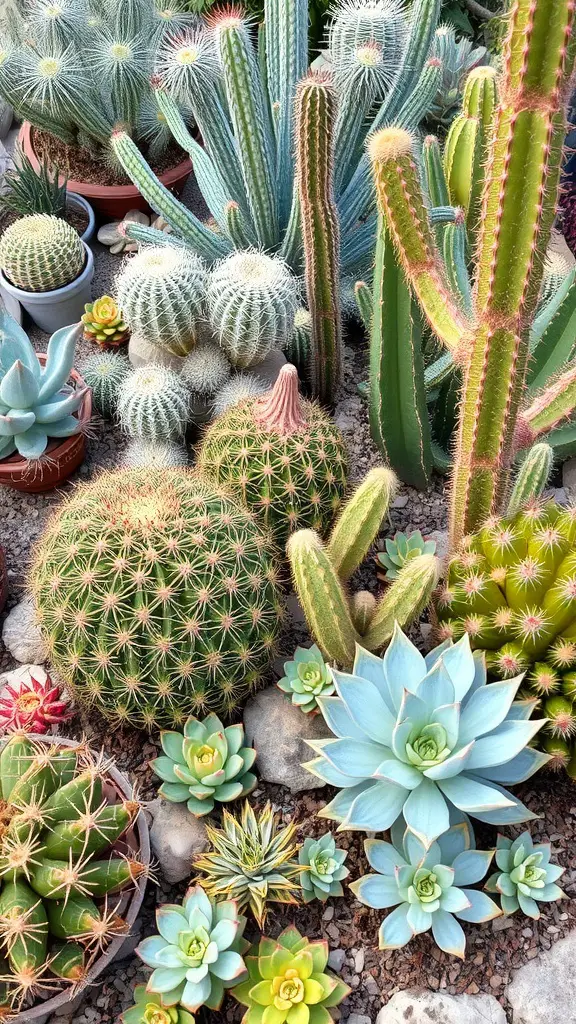
Creating a desert garden can be a fun and satisfying project. The image showcases a vibrant mix of cacti and succulents, perfect examples of plants that thrive in arid conditions. With their unique shapes and colors, these plants bring life to any outdoor space.
When selecting plants for your desert garden, consider starting with cacti. There are many varieties, each with its own character. Look for species like the round, spiky cactus and tall, slender ones. They’re not just resilient; they also add height and texture to your garden.
Succulents are another great choice. They come in various colors and sizes, as you can see in the image. Their fleshy leaves store water, making them easy to care for. Planting a mix of succulents can create a beautiful contrast and keep your garden looking fresh.
Don’t forget to consider soil and drainage. Good drainage is key in a desert garden. Use sandy soil to help prevent root rot. Also, think about placement. Grouping plants with similar sunlight needs together can make maintenance easier.
Lastly, remember that some plants can attract pollinators, which are beneficial for your garden. Incorporating flowering varieties can help bring in bees and butterflies. Enjoy designing your desert oasis!
Integrating Wildlife-Friendly Features

Creating a desert garden isn’t just about aesthetics; it’s also about inviting wildlife into your space. This image showcases a beautiful integration of birdhouses and a small water feature that can attract a variety of birds. The vibrant colors of the birdhouses stand out against the earthy tones of the sandy landscape.
The birdhouses in the garden provide safe nesting spots for local birds. It’s important to choose designs that are suitable for the species in your area. This can help increase the bird population and add life to your garden. Colorful birdhouses like the ones shown can also serve as delightful focal points.
Additionally, the water feature offers a refreshing spot for birds to drink and bathe. Keeping it clean and filled will ensure that it remains a popular spot. The small stones around the water help create a natural look and provide a perch for birds to land. This feature not only supports wildlife but also adds a soothing element to the environment.
Incorporating native plants around these features can further enhance the wildlife experience. Native plants attract beneficial insects and provide food sources for birds. By blending these elements, your desert garden can become a thriving habitat, welcoming the beauty of nature right to your doorstep.
Selecting Drought-Resistant Shrubs

When creating a desert garden, selecting drought-resistant shrubs is key. The image here showcases a vibrant desert landscape rich with colorful plants. Notice how the mixture of purple, orange, and yellow creates a lively yet harmonious feel. This diversity not only pleases the eye but also highlights the adaptability of these plants to arid conditions.
In your own garden, consider incorporating shrubs like lavender and sage. They thrive in dry environments and add fragrance to your space. Succulents and cacti are also excellent choices; their unique shapes and colors can bring a modern twist to traditional desert aesthetics.
Don’t forget about the importance of texture. The spiky cactus contrasts beautifully with the soft, rounded shapes of the flowering shrubs. This balance will add depth and interest to your garden. When selecting plants, think about how they will look together, especially as they grow.
Using Rocks and Boulders as Landscape Elements

When it comes to desert gardens, incorporating rocks and boulders can really elevate the look. The image showcases large boulders, creating a natural feel that blends seamlessly with the surrounding plants. These rocks provide a sense of permanence and strength, framing the garden beautifully.
The arrangement of the boulders can guide the eye and create pathways or focal points. Notice how the tall cactus stands proudly among the rocks, adding height and interest. This interaction between hard and soft elements makes the garden more inviting.
Using rocks also helps with drainage and soil stability, which is essential in a desert environment. The sandy ground around the boulders allows for good airflow while the rocks retain some moisture. It’s a practical choice that looks good too!
Adding smaller stones can further enhance the garden’s texture. They can fill gaps around larger boulders or create paths that lead you through the garden. This layering of materials makes the space feel more dynamic and engaging.
Enhancing Aesthetics with Decorative Gravel

Decorative gravel plays a vital role in the beauty of a desert garden. In the image, we see a winding path flanked by majestic cacti and lush greenery. The colorful gravel not only adds texture but also complements the natural elements around it.
Choosing the right type of gravel can transform an ordinary space into something inviting. The various shades of gravel create an eye-catching contrast against the earthy tones of the plants and the clear blue sky. It’s a simple yet effective way to enhance the overall look of your garden.
Moreover, gravel is practical. It helps with drainage and reduces weeds, which is especially useful in a desert setting where water conservation is crucial. By incorporating decorative gravel, you can create a serene pathway that invites exploration and relaxation.
Incorporating Water Features Sustainably
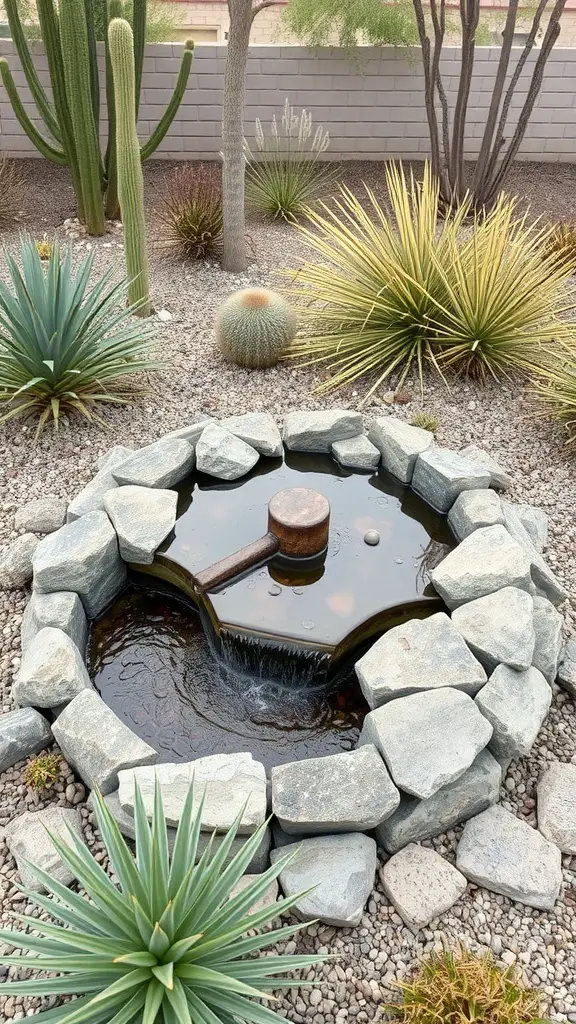
Water features can transform a desert garden into a serene oasis. The image showcases a small pond surrounded by rocks and various desert plants. This setup not only looks appealing but also supports local wildlife.
Sustainability is key when adding these features. The pond in the image is designed to collect and reuse water, minimizing waste. You could consider adding a simple pump to circulate water, which helps keep it clean and fresh.
Choosing plants that thrive in arid conditions is also important. Succulents and cacti, like those seen around the pond, require minimal water and add beautiful texture. Grouping plants with similar needs saves water and creates a balanced landscape.
Another great idea is to incorporate rainwater harvesting. By directing rainwater into your pond, you create a self-sustaining system that benefits both your garden and the environment.
Finally, don’t forget about the sound of water! The gentle trickle from your feature can drown out noise and create a peaceful atmosphere. It’s an inviting spot for relaxation, making your desert garden a true retreat.
Building Raised Garden Beds for Drainage

When creating a desert garden, proper drainage is key to keeping your plants healthy and thriving. Using raised garden beds can be an effective solution. These beds are elevated, which allows for better water runoff, preventing roots from sitting in water. This is especially important in sandy or clay soils that can retain moisture too long.
The image above showcases a beautifully designed arrangement of raised beds filled with a variety of succulents and cacti. Notice how each bed is distinct yet complements the overall look of the garden. This not only aids in drainage but also adds an attractive element to your landscape.
To build your raised garden beds, start with rot-resistant wood like cedar or redwood. Cut the wood to your desired height and width, and then join the corners securely. Make sure to leave some space at the bottom for drainage holes. Fill the beds with a mix of soil and sand to improve drainage further.
Incorporating different types of plants, as seen in the image, can also enhance your garden’s aesthetic. Varieties like aloe, agave, and small flowering succulents do well in these conditions. Rotate the plants to ensure they get enough sun, and remember to water them sparingly.
Creating Shade with Strategic Planting
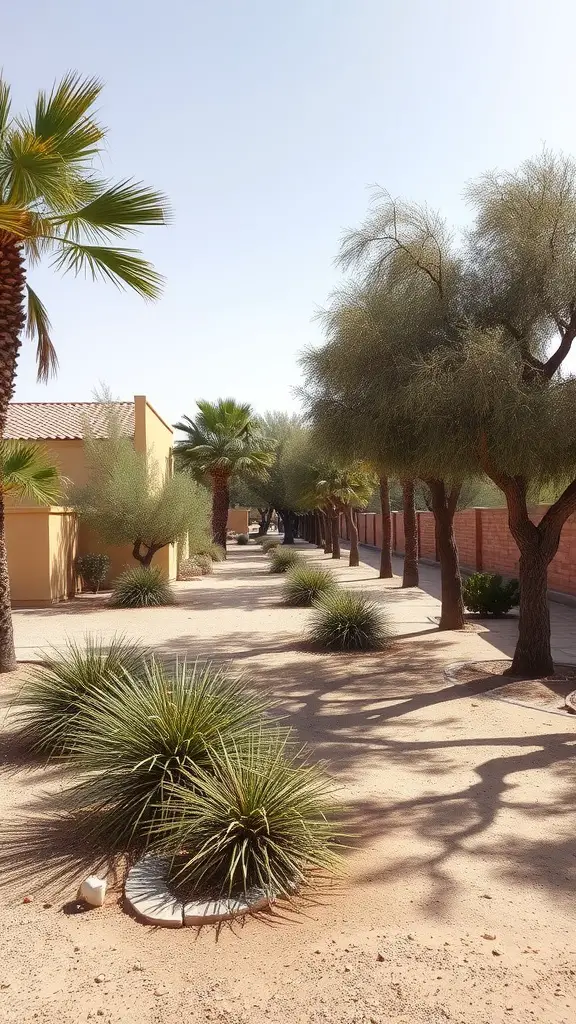
In a desert garden, shade is a precious commodity. This image captures a beautifully arranged pathway lined with palms and other trees, offering a cool retreat from the harsh sunlight. The tall trees provide dappled shade, allowing plants and walkways to escape the full intensity of the sun.
When planning your garden, consider the placement of your trees. Positioning them to create a natural canopy can transform a hot space into a welcoming area. In this setting, the combination of palm trees and other foliage not only adds aesthetic value but also serves a practical purpose.
The ground cover, with its low-growing plants, benefits from the shade while enhancing the overall beauty of the garden. Using native plants that thrive in dry conditions can reduce water needs while ensuring a lush appearance. This approach can create a sustainable oasis, perfect for enjoying the outdoors.
Think about adding seating areas in shaded spots. A bench or a few chairs under the trees can invite relaxation. This arrangement allows you to fully enjoy your garden, making it an ideal place for gatherings or quiet moments. With the right mix of plants and careful planning, your desert garden can be a shady haven.
Employing Vertical Gardening Techniques

Vertical gardening is a fun way to add greenery to your space, especially when dealing with limited ground area. Just look at this image filled with colorful succulents and cacti! Each plant adds its own unique vibe, creating a mini desert oasis.
These vertical gardens are not just pretty; they also save space. By planting upwards, you can fit more plants into a smaller area, maximizing your garden’s impact. This technique works well in urban settings where space is at a premium, allowing you to enjoy nature right outside your window.
Using various shapes and colors can create visual interest. Notice how the different textures of the plants, from soft succulents to spiky cacti, come together beautifully. You can mix and match plants to reflect your style, making your vertical garden truly yours.
Another benefit of vertical gardening is the ease of care. Many succulents thrive with minimal attention, making them perfect for busy folks. Plus, they’re drought-resistant, which is a bonus in dry climates. This means you can enjoy your garden without worrying much about watering.
So, if you’re thinking about starting a vertical garden, consider using a variety of succulents. They are hardy, colorful, and sure to bring some joy into your life!
Planning for Seasonal Changes
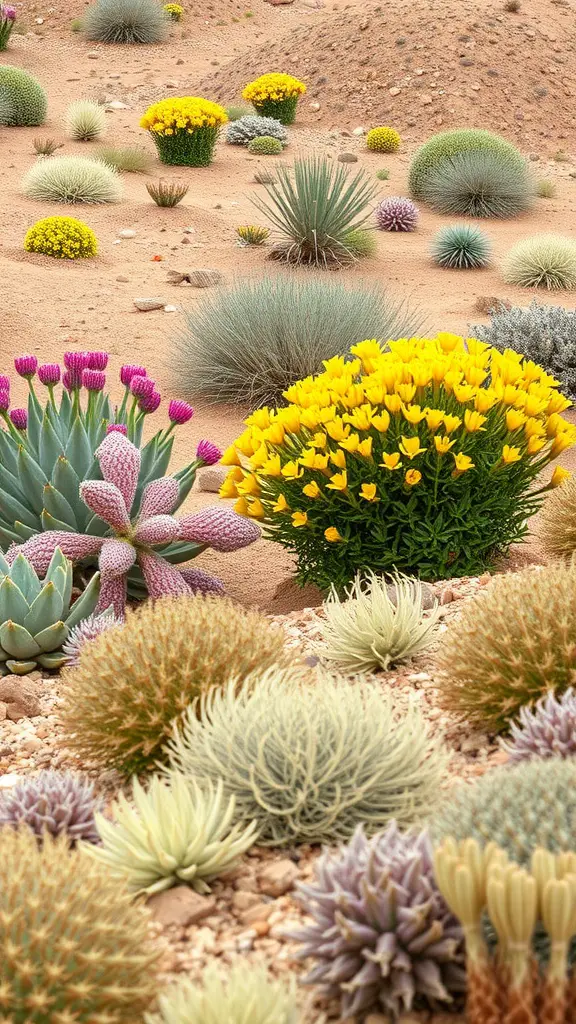
In a desert garden, planning for seasonal changes is essential. The image showcases a vibrant mix of cacti and flowering plants, all thriving in a sandy landscape. This blend of textures and colors highlights the beauty of a well-thought-out garden.
When designing your garden, consider how different plants respond to seasonal shifts. For instance, the bright yellow blooms in the foreground add a cheerful touch during spring. Meanwhile, the subtle greens of succulents provide a lovely backdrop year-round.
Watering schedules should also adapt to the seasons. In hotter months, plants may need more frequent watering, while in cooler weather, it’s important to allow the soil to dry out. This helps prevent root rot, ensuring your plants remain healthy.
Additionally, think about which plants will offer visual interest throughout the year. Choosing a variety of species that bloom in different seasons creates a dynamic landscape. Incorporating plants that showcase unique shapes, like the spiky succulents, adds depth to your garden design.
Creating Microclimates Within the Garden

In a desert garden, creating microclimates is essential for plant diversity and health. The image shows a well-designed desert landscape, where curves and rocks create variations in sunlight and moisture.
Microclimates are small areas where the climate differs from the surrounding environment. In this garden, you can see how strategically placed plants and stones can trap moisture and provide shade. This allows different plants to thrive even in harsh conditions.
Using native plants, like cacti and succulents, helps enhance these microclimates. They are adapted to the desert’s extremes and can benefit from the cooler spots created by larger plants. Positioning these plants near rocks can provide additional shelter from the sun.
Lastly, paths and the layout of the garden also play a role. The winding routes in the image guide airflow and create areas of interest while benefiting the overall ecosystem. So, next time you think about your garden, remember that small changes can lead to a healthier, more vibrant space.
Emphasizing Color Contrast with Foliage

In a desert garden, color contrast plays a key role in creating visual interest. This image showcases a stunning array of plants, each bringing its unique hue to the scene. The vibrant yellow blooms stand out against the earthy tones of the gravel, drawing the eye and inviting exploration.
The combination of textured foliage adds depth to the garden. Notice how the spiky forms of the plants, like the striking red and yellow varieties, create a dynamic display. These contrasting colors make the space feel lively and engaging, turning a simple landscape into a vibrant masterpiece.
Using color contrast effectively can also enhance the overall experience of the garden. When you walk through such a space, the variety of colors and shapes prompts curiosity and appreciation for nature’s artistry. It’s a reminder that even in the most arid conditions, life thrives in stunning forms.
Lighting for Evening Ambiance
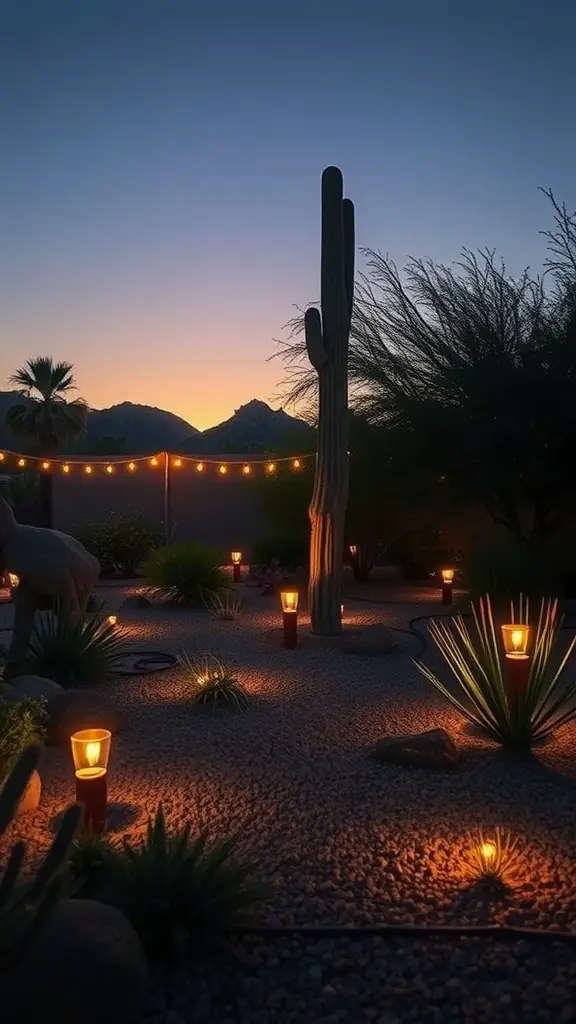
As the sun sets over the desert, the lighting in your garden can transform the space into a cozy retreat. In this image, you can see how warm lights set amidst the gravel and plants create a welcoming vibe. The soft glow contrasts beautifully with the darkening sky, inviting you to linger and relax.
The string lights overhead add a charming touch, outlining the space while casting gentle illumination. They are perfect for evening gatherings or quiet nights under the stars. Pair these with ground lights that highlight the unique desert plants, like the tall cactus and vibrant agave, to enhance the natural beauty.
When planning your evening ambiance, consider the balance between functional and decorative lighting. You want enough brightness to navigate the space, but also a soft glow that makes everything feel intimate. Layering different light sources can achieve this effect, making your garden an appealing spot to unwind.
Choosing the Right Mulching Techniques

Mulching is an essential step in maintaining a desert garden. The image above showcases different mulching materials that can enhance your garden’s health and appearance.
On the left, you can see a darker mulch that looks rich and packed. This type is usually organic and can break down over time, adding nutrients back into the soil. It’s perfect for helping retain moisture in hot climates.
The area on the right shows a mix of small rocks and wood chips. This is a great option for arid environments, as it helps to minimize evaporation while also suppressing weeds. Plus, it adds an attractive element to your landscape, blending well with the natural desert feel.
Choosing the right technique is vital. Think about your plants’ needs and the local climate. For instance, if you have drought-tolerant species, a rock mulch may be ideal. Conversely, if you’re growing more moisture-loving plants, organic mulch would serve you better.
Engaging with Local Gardening Communities

Connecting with local gardening communities can be a rewarding experience. The image shows a group of people gathered in a desert garden, surrounded by a variety of native plants like cacti and colorful flowers. This setting perfectly illustrates how community members can learn from one another while appreciating the beauty of their local environment.
These gatherings often provide a chance to share knowledge about sustainable gardening practices. Whether it’s discussing water-saving techniques or swapping tips on plant care, you can gain insights that may transform your own gardening approach.
Joining local workshops or events in locations like this desert garden can also introduce you to like-minded individuals. You can build friendships, share plant cuttings, and even collaborate on community projects. It’s a great way to feel more connected to your area while enhancing your gardening skills.
So, if you’re passionate about gardening, don’t hesitate to reach out to your local gardening groups. There’s a whole world of knowledge waiting for you, and you might even discover new favorite plants unique to your region!
Maintaining Your Desert Garden Year-Round
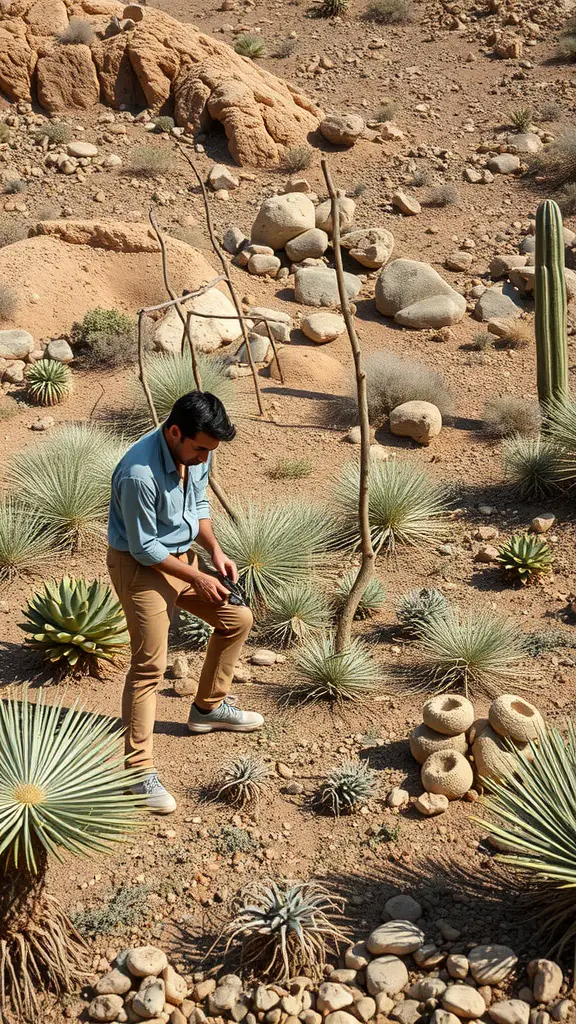
Desert gardens can be a joy to maintain, offering unique beauty and low water needs. This image shows a person tending to a vibrant desert landscape filled with various succulents and cacti. The sandy soil and rocky terrain reflect the natural beauty of a desert environment. Regular care ensures these plants thrive, even in harsh conditions.
Watering is crucial, but it’s important to do it wisely. Less frequent, deep watering encourages roots to grow deeper and seek moisture. During the hotter months, check the soil moisture regularly. If the top couple of inches are dry, it’s time to water.
Pruning is another essential task. Trimming dead leaves or spent flowers can help maintain the health and appearance of your plants. In this image, the person is likely examining the plants closely, which shows the level of care needed to keep a desert garden looking neat.
Mulching around the base of your plants can help retain moisture and reduce weeds. In desert conditions, using gravel or stones as mulch not only protects the soil but also adds to the aesthetic appeal. The contrasting textures in the image highlight how natural elements can enhance your garden’s design.
Lastly, keeping an eye out for pests is vital. Regular checks can prevent infestations. If you spot any issues, addressing them promptly can save your plants. Following these simple maintenance tips will help your desert garden thrive beautifully throughout the year.
Exploring Edible Plants for a Desert Garden

Creating a desert garden can be a fun way to enjoy the beauty of arid landscapes while incorporating some edible plants. In the image, you can see a variety of plants that thrive in dry conditions. These plants not only add character to your garden but can also provide delightful flavors for your meals.
The two succulent plants in the foreground, with their unique star-shaped formations, are not just visually appealing; they are often used in cooking. Many succulents can be edible, and some are even known for their health benefits. They can be used in salads or as garnishes, adding a fresh taste to your dishes.
In addition to succulents, you might spot other edible plants that flourish in the desert climate. For instance, certain types of cacti produce fruits that are both tasty and nutritious. The vibrant green plants in the background can also be a source of edible flowers or leaves, perfect for seasoning your meals.
When planning your desert garden, think about incorporating a mix of these plants. Not only will they thrive in harsh conditions, but they can also enhance your cooking with their unique flavors. Plus, it’s a satisfying experience to grow your own food right in your backyard!
Implementing Companion Planting Strategies

When you think of a desert garden, you might picture a landscape filled with unique plants that have adapted to harsh conditions. The image features a variety of cacti and succulents, showcasing how these plants can thrive together. The differing shapes, sizes, and colors create a beautiful, resilient ecosystem.
Companion planting in a desert garden is all about understanding which plants work well together. For example, certain succulents can provide shade and moisture retention for smaller plants, helping them flourish in dry conditions. The tall cacti here not only add height but also serve as a windbreak, creating a more sheltered environment for their neighbors.
To get started, consider planting low-water-use plants alongside more drought-tolerant varieties. The agave plants in the image, with their striking rosettes, can be paired with smaller succulents. This not only enhances the visual appeal but also maximizes space and resources.
Another tip is to group plants with similar water and sunlight needs. This means your watering routine becomes easier, and your plants can thrive with less stress. By observing the natural arrangements in the image, it’s clear that thoughtful placement of each plant can lead to a healthier garden.
Using Art and Sculptures to Enhance Landscape

Transforming a desert garden into a captivating space often involves the clever use of art and sculptures. In this scene, we see how various artistic elements blend harmoniously with the natural surroundings. The tall cacti and the smooth, rounded forms of sculptures create a pleasing contrast, embracing the essence of the desert landscape.
The sculptures stand tall and proud, drawing the eye and encouraging exploration. Their simple shapes add a modern touch while still respecting the natural vibes of the garden. The earthy tones of the sculptures complement the sandy soil and the green of the cacti, creating a cohesive look.
Adding different textures and materials can further enhance the environment. Notice the variety of stones and the unique arrangement of plants that add depth and interest. This thoughtful placement invites visitors to wander, appreciate, and ponder the relationship between nature and human creativity.
Finally, incorporating art into your landscape design doesn’t just beautify the space; it can also reflect personal style and narrative. Each piece can tell a story, making the garden feel more inviting and engaging. Whether you prefer bold pieces or subtle whispers of art, there’s a way to make it fit right into your desert garden.
Creating Areas for Relaxation and Reflection

In today’s busy world, having a peaceful spot to unwind is essential. The image showcases a lovely outdoor space that invites relaxation. A cozy chair with soft cushions beckons you to sit down and enjoy the moment.
The warm tones of the wall give a welcoming vibe. It’s a perfect backdrop for the lush greenery surrounding the area. Tall cacti and palm trees create a natural privacy screen, making it feel like a little oasis.
Adding personal touches can enhance this space. Consider placing a small table for your favorite drink or a book. A few plants can bring a sense of calm and connection to nature. This garden area is not just for decoration; it’s a place for gatherings or quiet reflection.
To enhance the ambiance, think about lighting. Soft lights or lanterns can make the space inviting during the evening. Overall, this area serves as a reminder to take a break and enjoy the beauty around us, making it a perfect retreat for relaxation.
Celebrating Cultural Heritage Through Garden Design

The image of a desert garden beautifully illustrates how cultural heritage can be celebrated through thoughtful garden design. This type of landscape often incorporates local flora, which not only thrives in the arid climate but also tells a story about the region’s history and culture.
In the foreground, we see a variety of cacti, which are iconic to desert environments. These plants symbolize resilience and adaptation, essential themes in many cultures that thrive in harsh conditions. Their unique shapes and sizes add visual interest, drawing attention to the way nature can be both functional and artistic.
Surrounding the cacti are smooth stones and sparse greenery, creating a tranquil atmosphere. The use of natural materials respects the environment while enhancing the garden’s overall aesthetic. This blend of plants and rocks reflects traditional landscaping techniques, showcasing a deep appreciation for the land.
The architectural elements in the background, with their historical style, further enrich the garden’s cultural narrative. They remind us how buildings and landscapes can work together to create spaces that honor local heritage. It’s a reminder that gardens are not just about plants; they are also about place and memory.

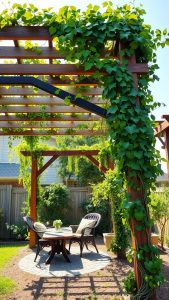
You could definitely see your skills within the work you write.
The arena hopes for even more passionate writers such as you who are
not afraid to mention how they believe. All the time go after your heart.
casino en ligne
It’s a pity you don’t have a donate button! I’d without a doubt donate
to this outstanding blog! I suppose for now i’ll settle for bookmarking and adding your
RSS feed to my Google account. I look forward to new updates
and will talk about this website with my Facebook group.
Talk soon!
casino en ligne fiable
Thanks for the marvelous posting! I definitely enjoyed reading it, you might be a great author.I will
make certain to bookmark your blog and will eventually come back in the future.
I want to encourage one to continue your great job, have a nice afternoon!
casino en ligne
Asking questions are really pleasant thing if you are not understanding something totally, except this paragraph gives nice understanding
even.
casino en ligne fiable
Simply want to say your article is as astonishing. The clarity
to your publish is simply spectacular and that i can assume you are
a professional in this subject. Well along with your permission allow me to seize your feed to stay up to
date with drawing close post. Thanks a million and please
continue the rewarding work.
casino en ligne
Hello, I enjoy reading all of your article post.
I like to write a little comment to support you.
casino en ligne
I don’t even know how I ended up here, but I thought this post was good.
I don’t know who you are but definitely you’re going to
a famous blogger if you are not already 😉 Cheers!
casino en ligne
I do not know if it’s just me or if perhaps everybody else encountering problems with your
blog. It appears as though some of the text in your posts are running
off the screen. Can somebody else please provide feedback and let me know
if this is happening to them as well? This could be a problem with my browser because I’ve
had this happen previously. Many thanks
casino en ligne
It’s very straightforward to find out any matter on web
as compared to textbooks, as I found this paragraph at this web page.
meilleur casino en ligne
Hi! I simply wish to give you a huge thumbs up for the excellent information you have here on this post.
I am coming back to your website for more soon.
casino en ligne France